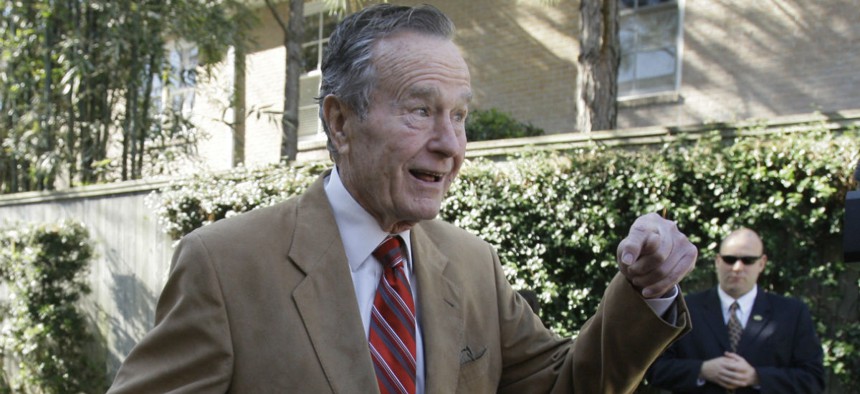
Former president George H.W. Bush stands outside his home in Houston in 2010. Pat Sullivan / AP file photo
Watchdog Sounds Alarm on Dead Alarm in Ex-President's Home
Secret Service left Houston home of George H.W. Bush vulnerable for 13 months.
In another in a series of reported performance lapses by the Secret Service, the Homeland Security Department’s watchdog on Thursday revealed that security alarms at the Houston home of former President George H.W. Bush were broken and left inoperable for 13 months.
“During this 13 month period, the Secret Service protective detail created a roving post to secure the home, and no security breach occurred,” said Inspector General John Roth in a memo to Secret Service Director Joseph Clancy. “The IG is bringing these vulnerabilities to the director’s attention because they may be affecting other protectees’ residences.”
Acting on a complaint, the IG staff began a review of all protectees’ homes that “revealed problems with identifying, reporting, and tracking alarm system malfunctions, and with repairing and replacing alarm systems,” the management advisory memo to Clancy said. When the probe first started, the Secret Service lacked a system for recording requests for equipment repairs, which were made without documentation by phone or email. The service now uses a more formal tracking procedure.
The IG recommended that the Secret Service reevaluate the process for requesting security equipment changes at all homes of former presidents. Agency officials agreed, and said changes would be complete by June 30.
“Startling and unacceptable,” was the reaction from House Oversight and Government Reform Committee Chairman Rep. Jason Chaffetz, R-Utah, and ranking member Rep. Elijah Cummings, D-Md., who issued a joint statement. “This adds to the growing list of significant concerns Congress has had with the management of the Secret Service. It is imperative that Director Clancy act swiftly on a host of fronts to restore the American people’s confidence in this agency.”
In a press release, IG Roth listed the other controversies at the Secret Service that his staff is currently investigating. They include:
- A 2011 incident when shots were fired at the White House;
- A 2014 incident when an armed guard came in close proximity to the president at a Centers for Disease Control event in Atlanta;
- The 2014 White House fence-jumping incident;
- A 2015 incident when an individual possibly known to the Secret Service landed a gyrocopter on the grounds of the U.S. Capitol.
Roth also laid out plans for probing more events, saying his office will issue public reports on:
- An allegation that two Secret Service supervisors in a government-owned vehicle drove through an active suspicious package investigation on March 4, 2015, in an attempt to enter the White House grounds upon their return from a retirement party;
- An allegation that, in March 2015, one or more Secret Service agents accessed, through the Secret Service data systems, the employment application of an individual who later became a member of Congress; and,
- An allegation that, in March 2015, a senior manager, after a farewell party involving drinking, sexually assaulted a female subordinate.







